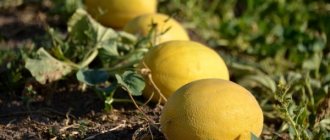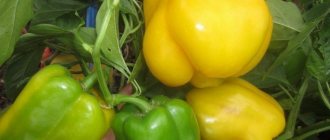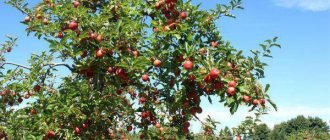Choosing a melon variety for central Russia
In central Russia, not many varieties of melons can be grown with guaranteed success. The most traditional ones, which are always heard, are Altai and Kolkhoznitsa. However, the range is currently by no means limited to these well-known representatives. At the same time, when choosing a variety for a region that is not too warm, you need to pay attention to whether it is zoned for cultivation in such a climate. Perhaps the variety you like can be planted, but only in a greenhouse.
Melon is slowly moving north, as new varieties and hybrids are constantly appearing that are resistant to the vagaries of weather and do not require a long summer. Therefore, in recent decades, this culture has been cultivated in the Bryansk, Kaluga, Ivanovo, and Nizhny Novgorod regions.
Early and mid-late varieties of melons are suitable for growing in central Russia
In any case, in the middle zone you have to limit yourself to early varieties (in extreme cases, medium ripening), since the late ones (and they are often the most delicious) will not have time to ripen here. If you look at the State Register of Breeding Achievements of the Russian Federation, it turns out that in the middle zone it is recommended to grow only one variety - Princess Svetlana. A few more are also suitable for similar climate conditions, for example:
- Collective farmer,
- Lesya,
- Lolita,
- Tender.
Of course, gardeners do not limit themselves to official recommendations and plant various varieties and hybrids, especially since their number is growing every year.
Melons for open ground:
- Cinderella is a high-yielding variety, one of the earliest ripening, producing small, slightly oval yellow fruits (weighing from 1 to 2 kg) with a wonderful honey taste. The growing season is just over 2 months: 60–72 days pass from germination to technical maturity. The variety is resistant to diseases and vagaries of weather, intended for fresh consumption: the fruits are stored for no more than 2 weeks;
- Altai is a variety that is almost as fast as Cinderella; harvesting is possible already in mid-summer. The fruits are yellow, elongated, weighing up to 1.5 kg. The pulp is less sweet, but beautiful, pale orange in color, and aromatic. The fruits are almost not stored and are intended for quick consumption after picking;
- Assol F1 produces yellow-orange round-shaped fruits weighing about 1 kg. The pulp is very juicy, sweet, aromatic, greenish in color. The growing season ranges from 80 to 90 days. Productivity - up to 1 kg/m2. Melons are stored for about 7 days, the variety is characterized by high resistance to diseases;
- Kolkhoznitsa is a widely known medium-ripening variety, grown in most of our country since 1943, the growing season ranges from 73 to 95 days. The fruit is an ideal ball weighing about 1 kg, yellow-orange in color, smooth. The pulp is almost white, sweet, juicy. Valued for its excellent taste and high yield, as well as its ability to be transported over long distances. The disadvantage of the variety is low resistance to many diseases;
- Lesya produces larger fruits, weighing more than 2 kg, yellow-orange in color, oval in shape. The pulp is tender, oily, white to cream in color. Ripens in 60–85 days. The aroma is common, characteristic of most varieties of melon, the taste is good. The variety is resistant to most diseases and extreme droughts, high-yielding.
Photo gallery: melon varieties for open ground
Cinderella - honey melon of early ripening Altai melon is almost not stored, it is eaten straight from the garden
Assol is not very beautiful on the outside, but tasty
Melon Kolkhoznitsa - an old, time-tested variety
Melon Lesya can withstand dry weather
Varieties for growing in greenhouses:
- Princess Svetlana. It takes about 3 months from germination to harvest. The fruits are spherical, almost white, weighing about 1.5 kg. The pulp is tender, juicy, orange in color, excellent taste, with a strong aroma. The fruits are stored for 2.5–3 weeks and tolerate transportation normally;
- Lada ripens 3 months after germination (74–96 days pass until technical maturity), the fruits weigh from 1.5 to 2 kg, are orange, round, very sweet. The pulp is light cream in color. The variety is disease-resistant, the melons do not crack, the presentation is excellent;
- Titovka is one of the fastest ripening varieties, the growing season is 55–70 days. The fruits are orange in color, slightly elongated, their size is very diverse: both miniature specimens and melons weighing up to 3.5 kg can be present in the garden at the same time. The pulp is pure white, fleshy, tasty. Disease resistance is at an average level;
- Krinichanka is another representative of very early varieties: the first melons ripen 70 days after germination. The fruits are round-oval, medium size (about 2 kg), yellow-orange. The pulp is very sweet, variable in color (from greenish to cream). The use of a greenhouse does not affect the speed of ripening: the variety can grow with a lack of natural light;
- Zlato Scythians F1 is an early ripening hybrid, the first fruits ripen in 75–80 days, they are round, small (about 1 kg), yellow in color. The pulp is sweet, aromatic, tender, very juicy. The presentation is good. The hybrid is famous for its high yield and good disease resistance.
Photo gallery: melon varieties for greenhouse cultivation
The Princess Svetlana melon is easy to recognize by its color, which is not typical for a melon. The Lada melon is distinguished by its very sweet pulp. The Titovka melon is an ultra-early ripening variety.
Melon Krinichanka is able to ripen even in insufficient light. Melon Zlato Scythians is a high-yielding hybrid for greenhouses
Advantages and disadvantages of individual varieties
For cultivation in Russia, you can choose one of the following varieties:
- Collective farmer. It can give an excellent harvest. This species is mid-season. The fruits are orange or dark green. The pulp is tender, cream or greenish in color. The weight of the fetus is 2 kilograms.
- Ozhen will bring a harvest of striped melons, where each stripe is either large yellow or thin green. The pulp is sweet and aromatic, has a protective green color. The variety is highly resistant to diseases and insect pests. Melon of this type is highly productive.
- The Torpedo variety is winter. It takes 113 days to mature. The weight of one fruit can reach 4-8 kilograms. The harvest is high. It grows well in the southern regions: in Crimea, Krasnodar Territory, Kazakhstan, Rostov Region.
For cultivation in the central regions of the Russian Federation: in Moscow, Moscow region, Leningrad region, any of the varieties is suitable:
Growing melon is a troublesome business. It requires hard work, perseverance, and diligence. However, the resulting result will allow you to enjoy delicious fruits.
General requirements for growing conditions
Melon needs a lot of heat and sun, which must be taken into account when choosing a location for the bed. It can withstand the most intense heat and very dry weather because it is able to extract moisture from the deep layers of the soil, but in humid climates it is not healthy.
The roots go deep into the ground up to 1 m or more, although this seems incredible when looking at very average-sized plants.
Melons do well at mild elevations because excess water does not accumulate there, in the presence of which most varieties quickly become ill. However, these hills must be reliably protected from cold winds.
The composition of the soil is of great importance: melon does not grow just anywhere. She loves soils that are light in structure: loams that are neutral in acidity are the best option. A lot of sand must be added to clayey soil, and acidic soil must be thoroughly limed. The best predecessors are cabbage, cucumbers, peas, garlic, and onions. It is not advisable to plant melons after any melons, tomatoes and carrots.
Due to the requirement for good lighting, they try to grow melons mainly in open ground: the walls of even the best greenhouse absorb a significant proportion of sunlight. However, in the middle zone, many gardeners are forced to plant crops in a greenhouse, since the risk of non-ripening in the garden is very high: summers vary.
Melons need a lot of space to grow properly.
In the central regions, only the earliest ripening varieties can be grown by sowing directly into the ground; in most cases, seedlings have to be prepared. And even at first they keep it in vegetable gardens under light film covers, removing them no earlier than June 10.
Historical records indicate that in the Moscow region, melons were planted about 500 years ago, using warm manure beds in greenhouses. They are prepared in advance using good doses of organic matter, covered with dark plastic film, in which holes are made. Melon seedlings are planted in them without removing the film for the whole summer, and in case of cold weather they are covered with non-woven materials.
Video: growing melon in a high bed
Diseases and pests of melon
Like any garden crop, melon in our areas can come under attack from viral, fungal and bacterial infections.
The most dangerous will be Fusarium. The plant is affected either at the stage of leaf formation or when fruiting. The lashes and leaves covered with gray spots lighten, wither and die in less than 10 days. Even if there is a hint of this disease, the plant will have to be destroyed.
Since Anthracnose (Copperhead) and Powdery Mildew have already been mentioned, let us recall Root Rot, to which weakened plants are susceptible. The bush itself may die because its roots and stem rot, and you risk getting an unripe melon that is rotten from the inside.
The destruction of garden pests is the direct responsibility of the owner of the site, since flying, crawling and gnawing insects are often also carriers of infectious diseases. For example, the melon fly spreads anthracnose, alternaria and fungal spores.
Growing an ancient agricultural crop, so valuable for its taste and medicinal qualities, cannot be called child's play, but this work is worth it to fully enjoy the taste, aroma and sweet pulp of this wonderful fruit a couple of months after planting! By the way, varieties such as Gavrish, Zlato Scythians and Blondie ripen perfectly in the corridor if they didn’t have enough of a short summer!
Sowing melon seeds in a garden bed
In the middle zone, sowing melons directly into the garden bed is rarely done. Since the deadline is mid-May, when warm weather has not yet set in, there is a high risk that the sprouts will die, and temporary film cover is absolutely necessary. But it is already quite possible to sow melon in a greenhouse in early May.
Sowing melons in open ground
Since melon is not sown very early, the bed can be prepared in the spring, but more often they try to do this in the fall. The area is dug up using a shovel, adding a bucket of well-rotted manure or compost per 1 m2. Shortly before sowing, sprinkle wood ash on the bed (up to 1 liter per 1 m2), level the soil with a rake, or better yet, with a cultivator.
Sowing seeds is possible a little earlier than planting seedlings, that is, after May 20: the ground at this time is already quite warm. While the seeds hatch and germinate, real warmth should come. The sowing scheme is similar to that for planting seedlings: the minimum distance between holes in a row is 50 cm, between rows - 70 cm.
Procedure:
- Make small holes with a scoop and add 1 tbsp. ash and a pinch of azofoska, mix and pour with warm water.
Azofoska is a valuable mineral fertilizer, but for melon you need to take very little of it
- Place 2-3 melon seeds in each hole to a depth of about 3 cm.
It’s very easy to take 2–3 seeds: they are quite large
- Cover the seeds with soil, compact them, and sprinkle with clean sand.
- If warm weather has not reliably established itself, cover the bed with spunbond.
After 10–12 days (and if it’s very warm, then even earlier), shoots will appear. As soon as it is clear which of them are stronger, one sprout is left in each nest.
Melons go well with corn, beans, radishes, and any fragrant herbs. You should not place potatoes and cucumbers nearby. There should be no trees nearby that create strong shading. Often, holes with melons alternate with planting watermelons.
Sowing seeds in a greenhouse
Melons are grown in unheated greenhouses: another option is unsuitable, since this crop needs sunlight, and heated greenhouses make sense in winter and early spring. To grow melons, you need to choose high greenhouses, at least 2 m high, otherwise the use of their space will be too wasteful. Each plant needs a lot of space, so melons in greenhouse culture are grown vertically, with a garter attached to strong trellises.
To prevent the trellises from occupying the main area of the greenhouse, they try to place them along the side walls. Accordingly, melon beds are prepared no further than 50 cm from the walls, and most often ridges up to 20 cm high are constructed into which single-row sowing is carried out. They try to maintain a distance of at least 40 cm between holes.
Melons are planted against the wall of the greenhouse, they are free there
The beds are prepared in advance, but in a greenhouse it is often necessary to completely replace the soil. This is especially important if melons and melons grew in the chosen place in previous years. The best soil for a greenhouse in which melons are supposed to be grown consists of low-lying peat and fine sand (3:1), to which chalk and azofoska are added for deoxidation (300 and 40 g per 1 m2, respectively). If there is no peat, and ordinary garden soil is used, it is fertilized in the same way as in open beds.
Sowing melons in a greenhouse is possible already in early May. The technique is no different from sowing in a garden, but you don’t need to cover the bed. Shoots will appear in 7–10 days, and for the first time it is advisable to slightly reduce the temperature in the greenhouse (to 16–18°C).
It is especially important that the greenhouse does not get hot at night.
Seed preparation
High-quality seedlings can only be obtained from high-quality seeds.
There will be no good harvest from first-year seeds! There will be no harvest at all, except for the harvest of large, profusely flowering male “gramophones”, long vines with bright burdock leaves.
To get both male and female flowers, you need to let the melon seeds “mature” for 3-4 years.
It is equally important to calibrate the seeds before sowing them - uniform seedlings are obtained from seeds of equal size and fullness (density).
If everything is clear with the external dimensions “by eye”, then the density of the seed is checked using a saline solution - like the freshness of a chicken egg.
Dissolve 1.5-2 tbsp in a liter jar of barely warm water. salt “without top” and add seeds selected by size. Let it sit for an hour or two.
Those that have sunk to the bottom are suitable for planting, the rest are thrown out with the water as unnecessary. We wash the “fat ones” and dry them on newspaper without heating.
What is the point of treating already calibrated seeds before planting? And how to do it right?
When processed in an elongated melon seed, important processes necessary for a high-quality harvest are activated, such as:
- awakening;
- inclusion of biological development;
- change in shell permeability;
- quick emergence of seedlings.
Seed processing and soaking
In the Pumpkin family, in order to increase the number of “lady” flowers and the friendly “pipping” of sprouts, the warming process is very important. This can be done “dry” or using a thermos.
For dry heating, melon seeds are placed in a 1.5-2 cm layer in a cold oven, which is gradually heated to 50-55 *, constantly stirring the layer of seeds.
For convenience, the seeds can be scattered into linen bags, laid out in flat pads (up to 2 cm) on a mesh and shaken, turning the bags over every 20-30 minutes. Dry heating time is 3-4 hours.
This is the first “dry” method.
The second method is to apply an even thin layer on the windowsill. 10 days, if the sun is already warming up the window sills well through the glass.
The third method is in a thermos. Mix boiling water with “well water” in a ratio of 50x50 and pour this water into the melon seeds in a thermos flask for the same 3-4 hours.
Warming up by any method is a guarantee of increasing the resistance of future plants to viral infections.
Soaking the seeds in melt water will help speed up the germination of melon seeds. Ordinary settled water at room temperature will also work. We will need a loose fabric bag immersed in this water, which will remain there until the seeds are completely swollen.
You can also soak it with the addition of various microfertilizers and microelements. Soaking with trace elements is a good start for any crop.
You can buy the nutrient mixture in the store and, after dissolving it in warm (but not hot!) water, soak the seeds.
You can prepare it yourself: 1 liter of water + 10 g of superphosphate + 0.2 magnesium sulfate + 5 g of potassium nitrate.
Slurry diluted 10 times or ash water left for 2 days (20g per 1l) is perfect.
Soaking should not last more than 24 hours!
Treatment and soaking can be done with the addition of oxygen, a hose and an aquarium compressor. The air from the narrow tube-hose will turn itself over and bubble the seeds in the nutrient broth.
After the resulting bath, the seeds should be slightly dried.
The next step to a good harvest is disinfection, which is often called “dressing” or “disinfection” of seeds. This will minimize the risk of melon being affected by fungal and bacterial diseases.
The simplest thing is irradiation with an ultraviolet lamp or direct sunlight for 2-3 days.
The most common is a 1% solution of potassium permanganate and bathing the seeds in it for 20-30 minutes.
Bathing in a 2% solution of hydrogen peroxide for 10-15 minutes is also good.
An aloe leaf soaked in water in a dark place for 5 days will also come in handy. Dilute the resulting infusion one to one and immerse a bag of seeds in it for a day.
A purely folk method of disinfection is garlic infusion. A large head of garlic is peeled and chopped, pour a glass of warm water over the floor and leave for about 3 hours. All that remains is to soak the melon seeds in the filtered infusion for 1-1.5 hours.
Wash the treated, disinfected seeds (lightly) and dry again. Slightly.
Pelleting
If desired, the seed can be panned. This is not a mandatory item, but desirable, because this will give the seed additional nutrition when growing the sprout.
Mixture for obtaining seed pills:
- peat – 600g;
- humus – 300g;
- mullein – 100g;
- superphosphate, ground into powder – 15g.
Sprinkle the slightly damp seeds with the resulting mixture and shake until the mixture coats them like breadcrumbs on a cutlet. Dry it. Spray it. We repeat the process until the crust of the mixture reaches 2-4 mm. This is how you get a “seed pellet”.
Hardening and vernalization
For a heat-loving crop like melon, seed hardening is the right choice! This will contribute to better adaptability of the young shoot to conditions somewhat different from the hot-arid zone of its homeland.
Let’s make a reservation right away: hardening and vernalization are different technologies, although to a beginner in growing melons these methods may seem a little different.
Vernalization is the preparation of seeds with a long germination period for cold-resistant crops.
Hardening is applicable only for heat-loving plants, increasing their resistance to changes in outdoor temperatures.
The hardening method is used for swollen, “ready” seeds of melon, pumpkin, zucchini, etc. from the cucumber genus, but they have not yet “hatched” to avoid rotting of the seed.
After swelling at room temperature, pre-prepared seeds (warming and soaking) are subjected to sharp cooling to 0*C - placed in the refrigerator for 5-10 days.
The second option is to transfer swollen seeds from +20* to cold 0* for 12 hours. They take it out, let it warm up in the room for the next 12 hours, then put it back in the refrigerator for the next 12. And so on for a week. When the seeds first try to sprout, we stop hardening. This means it's time to plant! The goal of hardening has been achieved - the germination rate for future early maturity has been increased significantly!
Dry seeds can also be frozen and hardened. Dry material is hardened from 0* to -10*, or even to -20*. It all depends on the variety.
After stress therapy with hardening, some seeds may refuse to sprout. This is fine. But the rest will produce magnificent plants that are stable and strong, with earlier flowering and a friendly yield.
Another advantage will be the possibility of earlier planting of seedlings in open ground.
Care for melons
Plant care consists of ordinary garden activities: watering, loosening, fertilizing. In addition, melon bushes have to be shaped so that they can produce a harvest: as a rule, too many fruits are set, and excess foliage is not needed. Caring for melons in and outside the greenhouse is somewhat different.
Growing melons in open ground
Melon does not require frequent watering: it is needed until the plant develops, and then only in the driest weather. Before fruit sets, as a rule, melons are watered once a week. It is important that the water is not too cold: in the evening it warms up well in the barrels in the sun. With the appearance of fruits, watering is carried out less and less, and when the melons grow to the size of a fist, they stop altogether.
Until the lashes have filled all the free space, after rains or watering, shallow loosening is carried out to remove the weeds. As soon as side shoots begin to appear, the melons are lightly earthed. They are fed:
- 10–15 days after planting the seedlings,
- with the appearance of the first flowers,
- at the very beginning of fruit filling.
You should not use mineral fertilizers; it is better to use mullein infusion with the addition of ash. If during the process of fruit growth it turns out that only one of them increases in size, fertilizing should be added.
Proper melon pruning is of great importance, consisting of pinching shoots, removing stepsons and excess fruits. As soon as it becomes clear that the seedlings have successfully taken root and begun to grow, the main shoot is pinched at its very top. After a few days, side shoots begin to grow, but there are too many of them, and you need to select the two strongest ones and remove the rest. The growing stepsons are also systematically broken out.
Any melon pruning scheme involves limiting the number of shoots and fruits
Most hybrids have a different fruiting pattern, and, on the contrary, they pinch off the side shoots after three leaves form on them, because the main crop will be formed on the main stem.
Even with the most careful care, a melon bush will not support more than 6 fruits (and the largest ones - only 2-3 pieces), so the rest will have to be sacrificed. Since melon plants are rarely grown on trellises in open ground, it is worth placing small plywood or planks under each fruit so that the melons do not lie on bare ground and do not rot in case of rain.
Special Events at the Greenhouse
In the greenhouse, artificial pollination is added to all the above activities. In the fresh air, this is done by flying insects, which rarely appear in protected ground. Of course, if the greenhouse is systematically ventilated (and this must be done), then the bees can fly into it, but even in this case the process cannot be left to chance. Therefore, the owner must himself pick several male flowers (those with a thin long petiole), tear off the petals from them and touch them several times to the insides of the female flowers. This should be done in the first day or two after the male flowers bloom, before the pollen has flown around.
Another feature of caring for melons in a greenhouse is growing them on a trellis to save space. These can be any stable vertical supports to which the melon vines are tied (they will not climb up on their own). Since ripening melons may fall, they (after reaching the size of an average apple) are placed in any suitable nets, which are tied to trellises.
The mesh is needed to prevent the melon from falling and breaking.
In the greenhouse, minimal pruning is carried out: excess fruits usually do not set there or die off very quickly. It is important not to overfill the water: excessive humidity in the greenhouse is fraught with the occurrence of diseases.
Video: melons in a greenhouse
Exotic varieties
"Vietnamese melon"
It differs sharply from its counterparts with a bright pattern of yellow and red-brown stripes. The taste of this melon is reminiscent of pineapple, and the pulp itself is very tender and pleasant.
"Melotropia rough" or "Mouse melon"
A very unusual variety, which is the smallest in the world in terms of fruit size. Melons are more like large, striped gooseberries, with characteristic pale yellow and bright yellow stripes. You can even grow it indoors. The taste is not sweet, but sour. It’s not very suitable for food, but it’s very suitable for compotes and jams.
"Kiwano" or "Horned Melon"
Unusual in shape, bright orange, with protruding spikes - “horns” and green cucumber interior, melon has become very popular due to its unusually fresh, slightly tart taste and many beneficial properties. A radical difference from other melons: Kiwano's seeds are eaten, each of which is surrounded by a bubble of tasty pulp.











